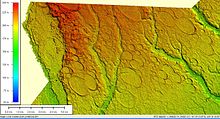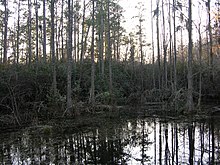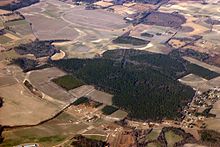Learn more about the Carolina Bays below.
Carolina bays are elliptical depressions concentrated along the Atlantic seaboard within coastal Delaware, Maryland, New Jersey, North Carolina, South Carolina, Virginia, Georgia, and northcentral Florida.[1][2] In Maryland, they are called Maryland Basins (Rasmussen and Slaughter 1955). Within the Delmarva Peninsula, they and other coastal ponds are also called Delmarva bays.[3]
Other landform depressions, not widely accepted as Carolina bays, are found within the northern Gulf of Mexico coastal plain in southeast Mississippi and Alabama, where they are known as either Grady ponds or Citronelle ponds.[4][5] Carolina bays vary in size from one to several thousand acres. About 500,000 of them are present in the classic area of the Atlantic Coastal Plain, often in groups, with each bay invariably aligned in a northwest-southeast direction. The bays have many different vegetative structures, based on the depression depth, size, hydrology, and subsurface. Many are marshy; a few of the larger ones are (or were before drainage) lakes; 36 square km (14 square mile) Lake Waccamaw is an undrained one. Some bays are predominantly open water with large scattered pond cypress, while others are composed of thick, shrubby areas (pocosins), with vegetation growing on floating peat mats. Generally the southeastern end has a higher rim composed of white sand. They are named for the bay trees frequently found in them, not because of the frequent ponding of water.[6]
Undrained, often circular to oval, depressions exhibiting a wide range of area and depth are also a very common feature of the Gulf of Mexico coastal plain within Texas and southwest Louisiana. These depressions vary in size from 0.4 to 3.6 km (0.25 to 2 miles) in diameter. Within Harris County, Texas, raised rims, which are about 0.65 m (2 ft) high, partially enclosed these depressions. In the scientific literature, they are known by a variety of names, including pocks, pock marks, bagols, lacs ronds, and natural ponds.[7][8]
Ecological significance and biodiversity[edit]
|
|
The bays are especially rich in biodiversity, including some rare and/or endangered species. Species that thrive in the bays' habitats include birds, such as wood storks, herons, egrets, and other migratory waterfowl, mammals such as deer, black bears, raccoons, skunks, and opossums.
Other residents include dragonflies, green anoles and green tree frogs.
The bays contain trees such as black gum, bald cypress, pond cypress, sweet bay, loblolly bay, red bay, sweet gum, maple, magnolia, pond pine, and shrubs such as fetterbush, clethra, sumac, button bush, zenobia, and gallberry. Plants common in Carolina bays are water lilies, sedges and various grasses. Several carnivorous plants inhabit Carolina bays, including bladderwort, butterwort, pitcher plant, and sundew.
Some of the bays have been greatly modified within human history, under pressure from farming, highway building, housing developments and golf courses. Carvers Bay, a large one in Georgetown County was used as a bombing practice range during World War II. It has been drained and is mostly used for tree farming today. Others are used for vegetable or field crops with drainage.
In South Carolina, Woods Bay, on the Sumter-Florence County line near Olanta has been designated a state park to preserve it as much as possible in its natural state. Also in Clarendon County (near Manning), another bay, Bennett's Bay, is a Heritage Preserve.
Another bay in Bamberg County, South Carolina is owned by the South Carolina Native Plant Society, which has been developing a 52-acre (210,000 m2) preserve called the Lisa Matthews Memorial Bay, which is trying to preserve and increase the federally endangered wildflower Oxypolis canbyi (Canby's Dropwort) in the bay. The uplands area surrounding the bay is being restored from a loblolly pine plantation to the original longleaf pine. Included in the longleaf restoration is the restoration of wiregrass (Aristida beyrichiana) as a key understory plant. Its flammability aids in periodic burning, which is necessary for Canby's Dropwort and many of the other species unique to the environment.
Orientation[edit]
According to formally published papers and monographs,[2][9][10] the orientation of the long axes of Carolina bays systematically rotate northward along the Atlantic Coastal Plain from northern Georgia to northern Virginia; the average trend of the long axes of Carolina Bays varies from N16°W in east-central Georgia to N22°W in southern South Carolina, N39°W in northern South Carolina, N49°W in North Carolina, and N64°W in Virginia. Within this part of the Atlantic Coastal Plain, the orientation of the long axes of Carolina bays varies by 10 to 15 degrees.[2][9][10] If the long axes of these Carolina bays, as measured by Johnson (1942), are projected westward, they converge, neither in the Great Lakes nor Canada, but in the area of southeastern Indiana and southwestern Ohio.[2]
At the northern end of the distribution of Carolina bays within the Delmarva Peninsula, the average orientation of the long axes abruptly shifts by about 112 degrees to N48°E. Further north, the orientation of the long axes becomes, at best, distinctly bimodal, and exhibits two greatly divergent directions and, at worst, completely random and lacking any preferred direction.[2] Plate 3 of Rasmussen and Slaughter,[11] which is reproduced as Figure 51 of Kacrovowski,[2] illustrates the disorganized nature of the orientations of the long axes of Carolina bays within the northernmost part of their distribution within Somerset, Wicomico, and Worcester counties, Maryland.
At the southern end of their distribution, the Carolina bays in southern Georgia and northern Florida are approximately circular in shape. In this area, they have a weak northerly orientation.[2] The Carolina bays in southern Mississippi and Alabama are elliptical to roughly circular in shape. The measurement of the long axes of 200 elliptical Grady / Citronelle ponds found a very distinct orientation tightly clustered about N25°W in southwestern Baldwin County, Alabama.[4]
Within the Atlantic Coast Plain, the measured orientation of the long axes of Carolina bays and the Pleistocene direction of movement of adjacent sand dunes, where present, are generally perpendicular to each other. In southern Georgia and northern Florida, the northerly orientation is matched by a westerly orientation of the direction of Pleistocene movement of sand dunes.[12]
Northward from northern Georgia to Virginia, the average orientation of direction of Pleistocene movement of parabolic sand dunes systematically shifts along with the average orientation of the long axes of Carolina bays as to always lie approximately perpendicular to them. In The Delmarva Peninsula, the 112 degrees shift in the average trend of the long axes is also accompanied by a corresponding shift in the average direction of Pleistocene movement of parabolic sand dunes such that their direction of movement is also perpendicular to the long axes, as is the case in the rest of the Atlantic Coastal Plain.[10]
Age[edit]
Although some questions about their chronology remain a matter of discussion, a variety of dating techniques constrained the age of the Carolina bays. The consideration of multiple lines of evidence, e.g. radiocarbon dating, optically stimulated luminescence dating, and palynology, indicate that the Carolina Bays predate the start of the Holocene at least by tens of thousands of years to over a hundred thousand years. The range of dates can be interpreted that they were either created episodically over the last tens of thousands of years or were created at time over a hundred thousand years ago and have since been episodically modified.[13][14][15]
Palynology[edit]
The sequences of pollen zones recovered from cores of undisturbed sediment taken from various Carolina bays by Frey,[16][17] Watts,[18] and Whitehead,[19][20] document the presence of full glacial pollen zones within the sediments filling Carolina bays. The thick sediments, which were recovered in these cores and contain pollen characteristic of full glacial conditions could have accumulated within these Carolina bays only if they had existed prior to end of the last glacial epoch. The radiocarbon dates reported by Frey,[16][17]Watts,[18] and Whitehead,[19][20] from these Carolina bay cores fully corroborate both the glacial age of the pollen and the undisturbed nature of the sediments filling these Carolina bays as indicated by the reported layering of the sediments filling them and increasing age with depth of the pollen they contain.
Within cores of undisturbed sediments recovered from Big Bay, North Carolina, Brook and others[14] documented well-defined pollen zones consisting of distinct pollen assemblages. They found a stratigraphically consistent series of pollen zones, which increased in age consistently with depth from Holocene Stage to the Wisconsin Stage, back into marine isotope stage 5, 75,000 to 134,000 years BP. These pollen zones collaborate the dating of Big Bay by optically stimulated luminescence and radiocarbon dating.[14]
Stratigraphy of Big Bay[edit]
The physical relationship of Pleistocene sand dunes to Big Bay, South Carolina, and adjacent Carolina bays further demonstrates that they are tens of thousands of years old.[14] For example, during the Pleistocene, sand dunes have migrated from the valley wall of the Wateree River into, and partially filled, Big Bay and an adjacent Carolina bay. According to basic principles of cross-cutting relationships and superposition, both Carolina bays were first created and the sand dunes later migrated into them. Thus, the sand dunes must be younger than Carolina bays. Since the sand dunes have been dated by optically stimulated luminescence dating at 29,600 ± 2,400 to 33,200 ± 2,800 BP, both Carolina bays must be older than these dates.[14]
Radiocarbon dates[edit]
Numerous radiocarbon dates have been collected from the sediments, which fill the basins of Carolina bays. The majority of these samples, from which these dates were obtained, were collected from cores of undisturbed sediments that filled Carolina bays in North and South Carolina. These cores were collected to reconstruct region paleoenvironmental records using pollen, diatoms, and other fossils found in the distinctly and conformably layered sediments that fill the Carolina bays.[14][16][17][18][19][19][21] Additional radiocarbon dates have been obtained from organic matter collected from the undisturbed sediments filling Carolina bays by Bliley and Burney,[22] Mixon and Pilkey,[23] Thom,[24] and Kaczorowski.[2] Many radiocarbon dates, which were obtained from organic matter preserved within undisturbed sediments are greater than 14,000 BP radiocarbon in age. The finite radiocarbon dates range in age from 440 ± 50 to 27,700 ±2,600 BP radiocarbon in age.[19][21] Some samples are so old, they contained insufficient radiocarbon for dating, which results in "greater than" dates. For example, samples from sediments filling Carolina bays have been dated at greater than 38,000 to 49,550 BP radiocarbon years.[14][16]
In cases where multiple radiocarbon dates have been determined from a single core, radiocarbon dates are typically consistent in terms of their stratigraphic position within a core and accumulation rates calculated from them only are rarely anomalous. Given the nature of radiocarbon dating, such discordant dates occasionally occur even in undisturbed deposits, when multiple samples were dated. The occasional discordant dates by themselves are meaningless as an indicator of disturbance. The intact internal stratigraphy of the bay sediments, as indicated by paleosols and pollen zones, e.g. Big Bay[14] refutes such arguments.
As discussed by Gaiser[21] and others, radiocarbon dates reported from any Carolina bay are all minimum dates for their formation. Because only organic matter can be dated by radiocarbon dating, the reported radiocarbon dates only represents times during which organic matter of some type accumulated in Carolina bays and was later preserved. At other times, datable organic matter would either not have been preserved as sediment accumulated within them, or older organic matter destroyed when they dried out completely. During glacial periods when sea level was 130 meters (400 ft) below present, the water table would have been below the bottom of the vast majority of the bays. At such times, any organic matter would have been destroyed by oxidization and weathering of the lake bottom. Also, at that time eolian processes would have eroded any existing sediments filling the bottom of many bays removing any older lake sediments and the pollen, and datable organic matter. As a result, it is highly unlikely that organic matter dating to the exact age of any Carolina Bay would have been preserved except in the deepest of them. Thus, the oldest radiocarbon date from a Carolina Bay only indicates when the water table rose high enough for a permanent lake or swamp to exist within it.[21]
Quite different from other studies were the dates that were yielded by samples collected by Firestone and others[25] from 15 Carolina bays that they studied for carbon spherules, vitreous charcoal and charcoal deposits, looking for evidence of an extraterrestrial impact. Carbon dating of the carbon spherules mostly gave dates in the future, this was interpreted as an unusual enrichment of the 14C at the time these deposits were laid down. Carbon dating of the vitreous charcoal and charcoal gave dates from 8,450 BP to 510 in the future, again interpreted as 14C enrichment. Firestone and others interpreted that this 14C enrichment was connected to the sudden 14C increase that has been observed at the beginning of the Younger Dryas 12.9 kyr ago (see his fig 9)[25]
Optically stimulated luminescence dating[edit]
Since the mid-1990s, the dating of the sand rims of a number of Carolina bays by optically stimulated luminescence dating has been interpreted to indicate that the sand rims of a number of Carolina bays are as old as 80,000 to 100,000 BP and were formed primarily during and just prior to glacial stadials.[13][14][15][26][27] Based on the same optically stimulated luminescence dates, it is argued that the shape and size of the Carolina bays have been episodically modified during the Late Pleistocene when a climatic threshold was crossed during the start of a Pleistocene glacial stadial.[26][27]
Theories of origin[edit]
Theories of the origin of the Carolina bays fall into two major categories: that these features were created by forces within the Earth, or that they were gouged by an astronomical event or set of events.
Geomorphology[edit]
Various geomorphological hypotheses have been proposed to account for the bays, including action of sea currents when the area was under the ocean or the upwelling of ground water at a later time. One major hypothesis within the earth sciences academic community is that a combination of processes created the shapes and orientations of these ancient landforms, including climate change, the formation of siliciclastic karst by solution of subsurface material during glacial sealevel lowstands and later modification of these depressions by periodic eolian and lacustrine processes.
Quaternary geologists and geomorphologists argue that the peculiar features of Carolina bays can be readily explained by known terrestrial processes and repeated modification by eolian and lacustrine processes of them over the past 70,000 to 100,000 years.[28] Also, Quaternary geologists and geomorphologists believe to have found a correspondence in time between when the active modification of the rims of Carolina bays most commonly occurred and when adjacent sand dunes were active during the Wisconsinan glaciation between 15,000 and 40,000 years (Late Wisconsinan) and 70,000 to 80,000 years BP (Early Wisconsinan).[26][27] In addition, Quaternary geologists and geomorphologists have repeatedly found that the orientations of the Carolina bays are consistent with the wind patterns which existed during the Wisconsinan glaciation as reconstructed from Pleistocene parabolic dunes, a time when the shape of the Carolina bays was being modified.[10]
Impact event[edit]
The cometary impact hypothesis of the origin of the bays was popular among earth scientists of the 1940s and 50s. After considerable debate and research, geologists determined the depressions were both too shallow and lacking in any evidence for them to be impact features. Reports of magnetic anomalies turned out not to show consistency across the sites. There were no meteorite fragments, shatter cones or planar deformation features. None of the necessary evidence for hypervelocity impacts was found. The conclusion was to reject the hypothesis that the Carolina Bays were created by impacts of asteroids or comets (Rajmon 2009).
A new type of extraterrestrial impact hypothesis was proposed as the result of interest by both popular writers and professional geologists in the possibility of a terminal Pleistocene extraterrestrial impacts, including the Younger Dryas impact hypothesis. It said that the Carolina Bays were created by a low density comet exploding above or impacting on the Laurentide ice sheet about 12,900 years ago.[29] However, this idea has been discredited by OSL dating of the rims of the Carolina bays, paleoenvironmental records obtained from cores of Carolina bay sediments, and other research that shows that many of them are as old as, or older than, 60,000 to 140,000 BP.[13][14][15][30][31]
See also[edit]
References[edit]
- ^ Prouty, W. F., 1952, Carolina Bays and their Origin. Geological Society of America Bulletin vol. 63, no. 2, pp. 167–224.
- ^ a b c d e f g h Kaczorowski, R. T., 1977, The Carolina Bays: a Comparison with Modern Oriented Lakes Technical Report no. 13-CRD, Coastal research Division, Department of Geology, University of South Carolina, Columbia, South Carolina. 124 pp.
- ^ Coleman, D. (2001) Delmarva Bays: Natural Enigmas.Maryland Department of Natural Resources ArchivedSeptember 3, 2013, at the Wayback Machine., Annapolis. Maryland.
- ^ a b Otvos, E. G., 1976, "Pseudokarst" and "pseudokarst terrains"; problems of terminology. Geological Society of America Bulletin, v. 87, no. 7, pp. 1021–1027.
- ^ Folkerts, G. W., 1997, Citronelle ponds: little-known wetlands of the Central Gulf Coastal Plain. Natural Areas Journal. v. 17, pp. 6–16.
- ^ Sharitz, R. R., 2003, Carolina Bay Wetlands: Unique Habitats of the Southeastern United States. Wetlands. v. 23, no. 3, pp. 550–562.
- ^ Aronow, S., nda, A Digression on the origin of some anomalous undrained depressions mostly on the Pleistocene and Pliocene surfaces in the Gulf of Mexico PDF version, 48 KB Armand Bayou Watershed Working Group, The Texas Coastal Watershed Program, Houston Texas, 31 pp.
- ^ Aronow, S., ndb, Geomorphology and surface geology of Harris County and Adjacent parts of Brazoria, Fort Bend, Liberty, Montgomery, and Waller Counties, Texas PDF version, 68 KBArmand Bayou Watershed Working Group, The Texas Coastal Watershed Program, Houston Texas, 23 pp.
- ^ a b Johnson, D. W., 1942. The Origin of the Carolina Bays. New York: Columbia University Press.
- ^ a b c d Carver, R. E., and G. A. Brooks, 1989, Late Pleistocene paleowind directions, Atlantic Coastal Plain, U.S.A. Palaeogeography, Palaeoclimatology, Palaeoecology. v. no. 3-4, pp. 205–216.
- ^ Rasmussen, W. C., and T. H. Slaughter, 1955, The ground water resources, in The water resources of Somerset, Wicomico, and Worcester Counties . Bulletin no. 16, Maryland Geological Survey, Baltimore, Maryland, 170 pp.
- ^ Markewich, H. W., and W. Markewich, 1994, An overview of Pleistocene and Holocene inland dunes in Georgia and the Carolinas; morphology, distribution, age, and paleoclimate. Bulletin no. 206, United States Geological Survey, Reston, Virginia, 932 pp.
- ^ a b c Brooks, M. J., B. E. Taylor, and J. A. Grant, 1996, Carolina Bay geoarchaeology and Holocene landscape evolution on the upper coastal plain of South Carolina. Geoarchaeology. v. 11, no. 6, pp. 481–504.
- ^ a b c d e f g h i j Brooks, M. J., B. E. Taylor, P. A. Stone, and L. R. Gardner, 2001, Pleistocene encroachment of the Wateree River sand sheet into Big Bay on the Middle Coastal Plain of South Carolina. Southeastern Geology. v. 40, pp. 241–257.
- ^ a b c Grant, J. A., M. J. Brooks, and B. E. Taylor, 1998, New constraints on the evolution of Carolina Bays from ground-penetrating radar. Geomorphology, v. 22, no. 3-4, pp. 325–345.
- ^ a b c d Frey, D. G., 1953, Regional aspects of the late-glacial and post-glacial pollen succession of southeastern North Carolina. Ecological Monographs. vol. 23, no. 3, pp. 289–313.
- ^ a b c Frey, D. G., 1955, A time revision of the Pleistocene pollen chronology of southeastern North Carolina. Ecology. v. 36. no. 4, pp. 762–763.
- ^ a b c Watts, W. A., 1980, Late-Quaternary vegetation history at White Pond on the inner coastal plain of South Carolina. Quaternary Research. v. 13, no. 2, pp. 187–199.
- ^ a b c d e Whitehead, D. R., 1964, Fossil pine pollen and full-glacial vegetation in southeastern North Carolina. Ecology. v. 45, no. 4, pp. 767–777.
- ^ a b Whitehead, Donald R., 1981, Late-Pleistocene vegetational changes in northeastern North Carolina. Ecological Monographs. v. 51, no. 4, pp. 451–471
- ^ a b c d Gaiser, E. E., B. E. Taylor, and M. J. Brooks, 2001, Establishment of wetlands on the southeastern Atlantic Coastal Plain; paleolimnological evidence of a mid-Holocene hydrologic threshold from a South Carolina pond. Journal of Paleolimnology. v. 26, no. 4, pp. 373–391.
- ^ Bliley, D. J., and D. A. Burney, 1988, Late Pleistocene climatic factors in the genesis of a Carolina Bay. Southeastern Geology. v. 29, no. 2, pp. 83–101.
- ^ Mixon, R. B., and O. H. Pilkey, 1976, Reconnaissance geology of the submerged and emerged Coastal Plain province, Cape Lookout area, North Carolina. Professional Paper no. 859, U. S. Geological Survey, Reston, Virginia.
- ^ Thom, B. C., 1970, Carolina Bays in Horry and Marion County, South Carolina. Geological Society of America Bulletin. v. 81, no.3, pp. 783–814.
- ^ a b Firestone, R. West, A. Kennett, J. Becker, L. Bunch, T, Revay, Z and others (2007) Evidence for an extraterrestrial impact 12,900 years ago that contributed to the megafaunal extinctions and the Younger Dryas cooling. Proceedings of the National Academy of Science. vol. 104 no. 41, pp. 16016–1602.
- ^ a b c Brooks, M. J., B. E. Taylor, and A. H. Ivester, 2010, Carolina Bays: Time capsules of Culture and Climate Change. Southeastern Archaeology. v. 29, no. 1, pp. 146-163.
- ^ a b c Savannah River Archaeological Research Program Staff, 2010, Annual review of Cultural Resource Investigations by Savannah River Archaeological Research Program. South Carolina Institute of Archaeology and Anthropology, Columbia, South Carolina. 135 pp.
- ^ May, J. H., and A. G. Warne, 2004, Hydrogeologic and geochemical factors required for the development of Carolina Bays along the Atlantic and Gulf of Mexico, coastal plain, USA. Environmental & Engineering Geoscience, v. 5, no. 3, pp. 261-270.
- ^ J. Ronald Eyton & Judith I. Parkhurst, 1978, A Re-evaluation of the Extraterrestrial Origin of the Carolina Bays
- ^ Leigh, D. S., 2008, Late Quaternary climates and river channels of the Atlantic Coastal Plain, southeastern USA. Geomorphology. v. 101, pp. 90–108.
- ^ Markewich H. W., R. J. Litwin, D. A. Wysocki, and M. J. Pavich, 2015, Synthesis on Quaternary aeolian research in the unglaciated eastern United States. Aeolian Research. vol. 17, pp. 139–191.
External links[edit]
- Anonymous, 2007, Geology and Ecology of Carolina Bays. Southeastern Section–56th Annual Meeting (29–30 March 2007) Savannah, Georgia.
- Bob, nd, More Carolina Bay Information., Comets, Culture, and Currency? Web Site, Athens, Georgia.
- Davias, M., and J.L. Gilbride, 2011, LiDAR-Derived Digital Elevation Maps Of The Delmarva Peninsula And Southern New Jersey Used To Identify Carolina Bay Landforms; Their Planform Shape And Orientation Changes Systematically With Latitude. Geological Society of America Abstracts with Programs. v. 43, no. 5, p. 629.
- Eyton, R.J., and J.I. Parkhurst, 1975, Analysis of Extraterrestrial Origin of Carolina Bays. Paper no. 9, Geography Graduate Student Association, University of Illinois, Urbana, Illinois.
- Goodwin, B.K., and G.H. Johnson, 1970, Carolina Bays in the Upland Gravels of Midlothian, Virginia. Part 2, Eleventh Annual Field Conference of the Atlantic Coastal Plain Geological Association Guidebook. Williamsburg, Virginia, The College of William and Mary. 30 pp.
- Howard, G.A., 1997, The Carolina Bays. North Carolina.
- Ivester, A.H., M.J. Brooks, and B.E. Taylor, 2007, Sedimentology and Ages of Carolina Bay Sand Rims. Geological Society of America Abstracts with Programs. v. 39, no. 2, p. 5.
- Ivester, A.H., D.I. Godfrey-Smith, M.J. Brooks, and B.E. Taylor, 2003, Concentric sand rims document the evolution of a Carolina Bay in the middle coastal plain of South Carolina. Geological Society of America Abstracts with Programs. v. 35, no. 6, p. 169.
- May, J.H., and A.G. Warne, 1999, Hydrogeologic and geochemical factors required for the development of Carolina Bays along the Atlantic and Gulf of Mexico, coastal plain, USA Environmental & Engineering Geoscience. v. 5, no. 3, pp. 261–270.
- Moore, C.M., and M.J. Brooks, 2011, Evidence for Widespread Eolian Activity in the Coastal Plain Uplands of North and South Carolina Revealed by High-Resolution LiDAR Data. PDF version Geological Society of America Abstracts with Programs. v. 43, No. 2, p. 76.
- Moore, C.M. M. J. Brooks, A.H. Ivester and T.A. Ferguson, 2011, Geoarchaeological Investigations of Carolina Bays in South Carolina: Methodological Approaches for Interpreting Site Formation Processes, Archaeostratigraphy and Geochronology. PDF version Geological Society of America Abstracts with Programs. v. 42, no. 1, p. 70.
- Pinter, N., and S.E. Ishman, 2008, Impacts, mega-tsunami, and other extraordinary claims PDF version, 304 KB. GSA Today. vol. 18, no. 1, pp. 37–38.
- Diane Tennant Series About Carolina Bays
- Tennant, Diane, 2008a, The Carolina bays: Explaining a cosmic mystery, Part 1 The Virginian-Pilot, (September 7, 2008)
- Tennant, Diane, 2008b, Are Carolina bays related to the extinction of the mammoth?, Part 2 The Virginian-Pilot, (September 8, 2008)
- Tennant, Diane, 2008c, The Carolina bays: New evidence points to a killer comet, Part 3 The Virginian-Pilot, (September 8, 2008)




